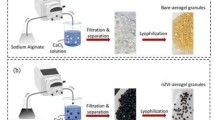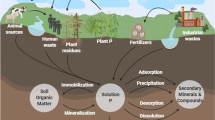Abstract
Agriculture P management practices elevate the level of inorganic phosphates in soil that results in phosphorous (P) seepage into water-bodies. This is one of the key factors that have accelerated the menace of eutrophication. Phytic acid (phytate)-P-rich plant metabolite is infamous for its anti-nutrient activity and regularly oozing in to environment though discharge of mono-gastric animals. That has amplified the magnitudes of eutrophication. In this work, for catalysis of phytate-P, the metal-organic framework fabricated towards metal oxides (Fe3O4) and phytase in highly ordered microcosms of silica was employed. The synthesized framework was characterized through transmission electron microscopy (TEM) and nitrogen isotherm analysis. Average pore diameter of synthesized bisect oval shaped structures was measured around ≈200 nm. Herein, phytase and Fe3O4 nanoparticles were loaded to the cavities of microcosms through glutaraldehyde-mediated crosslinking. Whereas Fe3O4 nanoparticles act as nano-absorbents that adsorb P liberated from phytase-mediated catalysis of phytate. Kinetic analysis of free and loaded phytase has shown relatively small reduction in catalytic efficiency. These loaded microcosms have removed 60–80% of phytate-phosphate. The optimized process has reduced the growth of photoautotrophs by 50%. Additionally the magnet-assisted separation of loaded microcosms eased the reapplication of loaded microcosms tested for six independent instances. The primary studies conducted to evaluate the geno-toxicity of loaded microcosms have not shown any harmful effect on the process like cell division and seed germination. The efficacy of this method has evaluated towards on-field testing in Changa (Gujarat, India) lake.












Similar content being viewed by others
References
Bach LT, Riebesell U, Sett S, Febiri S, Rzepka P, Schulz KG (2012) An approach for particle sinking velocity measurements in the 3–400 μm size range and considerations on the effect of temperature on sinking rates. Mar Biol 159(8):1853–1864
Chiche D, Schweitzer JM (2017) Investigation of competitive COS and HCN hydrolysis reactions upon an industrial catalyst: Langmuir-Hinshelwood kinetics modeling. Appl Catal B Environ 205:189–200
Coelho JV, Guedes MS, Prado RG, Tronto J, Ardisson JD, Pereira MC, Oliveira LC (2014) Effect of iron precursor on the Fenton-like activity of Fe2O3/mesoporous silica catalysts prepared under mild conditions. Appl Catal B Environ 144:792–799
Correll DL (1998) The role of phosphorus in the eutrophication of receiving waters: a review. J Environ Qual 27(2):261–266
Dalsgaard J, Schøn Ekmann K, Pedersen P, Verlhac V (2009) Effect of supplemented fungal phytase on performance and phosphorus availability by phosphorus-depleted juvenile rainbow trout (Oncorhynchus mykiss), and on the magnitude and composition of phosphorus waste output. Aquaculture 266:105–112
Daou TJS, Begin-Colin JM, Greneche F, Thomas A, Derory P, Bernhardt P, Legaré G, Pourroy (2007) Phosphate adsorption properties of magnetite-based nanoparticles. Chem Mater 19(18):4494–4505
Gemmell BJ, Adhikari D, Longmire EK (2014) Volumetric quantification of fluid flow reveals fish's use of hydrodynamic stealth to capture evasive prey. J R Soc Interface 11(90):20130880
Heinonen JK, Lahti RJ (1981) A new and convenient colorimetric determination of inorganic orthophosphate and its application to the assay of inorganic pyrophosphate. Anal Biochem 113(2):313–317
Hwang ET, Lee B, Zhang M, Jun SH, Shim J, Lee J, Kim J, Gu MB (2012) Immobilization and stabilization of subtilisin Carlsberg in magnetically-separable mesoporous silica for trans-esterification in an organic solvent. Green Chem 14(7):1884–1887
Kajihara M (1971) Settling velocity and porosity of large suspended particle. J Oceanogr 27(4):158–162
Kim J, Hongfei J, Chang-won L, Seung-wook C, Ja Hun K, Yongsoon S, Alice D, Byung-Gee K, Ping W, Grate JW (2006) Single enzyme nanoparticles in nanoporous silica: a hierarchical approach to enzyme stabilization and immobilization. Enzym Microb Technol 39:474–480
Lee G, Kim J, Lee JH (2008 May 5) Development of magnetically separable polyaniline nanofibers for enzyme immobilization and recovery. Enzym Microb Technol 42(6):466–472
Long F, Gong J, Guang-Ming Z, Long C, Xi-Yang W, Jiu-Hua D, Qiu-Ya N, Hui-Ying Z, Xiu-Rong Z (2011) Removal of phosphate from aqueous solution by magnetic Fe–Zr binary oxide. Chem Eng J 171:448–455
Matott LS, Rabideau AJ (2008) ISOFIT–a program for fitting sorption isotherms to experimental data. Environ Model Softw 23(5):670–676
Murphy JA, Riley JP (1962) A modified single solution method for the determination of phosphate in natural waters. Anal Chim Acta 27:31–36
Pan B, Han F, Nie G, Wu B, He K, Lu L (2014) New strategy to enhance phosphate removal from water by hydrous manganese oxide. Environ Sci Technol 48(9):5101–5107
Qu X, Alvarez PJ, Li Q (2013) Applications of nanotechnology in water and wastewater treatment. Water Res 47(12):3931–3946
Rafati L, Mahvi AH, Asgari AR, Hosseini SS (2010) Removal of chromium (VI) from aqueous solutions using Lewatit FO36 nano ion exchange resin. Int J Environ Sci Technol 7(1):147–156
Schindler DW, Carpenter SR, Chapra SC, Hecky RE, Orihel DM (2016) Reducing phosphorus to curb lake eutrophication is a success. Environ Sci Technol 50(17):8923–8929
Sun D, Hale L, Kar G, Soolanayakanahally R, Adl S (2017) Phosphorus recovery and reuse by pyrolysis: applications for agriculture and environment. Chemosphere 194:682–691
Umpleby RJ, Baxter SC, Chen Y, Shah RN, Shimizu KD (2001) Characterization of molecularly imprinted polymers with the Langmuir−Freundlich isotherm. Anal Chem 73(19):4584–4591
Wan S, Wu J, He F, Zhou S, Wang R, Gao B, Chen J (2017) Phosphate removal by lead-exhausted bioadsorbents simultaneously achieving lead stabilization. Chemosphere. 168:748–755
Wang H, Zhang L (2018) Efficient cleaning of cyanobacterial blooms using flocculants made of modified waterwork sludges. Environmental Chemistry Letters 16(1):265–273
Wodzinski RJ, Ullah AH (1996) Phytase. Adv Appl Microbiol 42:263–302
Xiao W, Liu X, Irwin AJ, Laws EA, Wang L, Chen B, Zeng Y, Huang B (2017) Warming and eutrophication combine to restructure diatoms and dinoflagellates. Water research 128(2018):206–216.
Author information
Authors and Affiliations
Corresponding author
Additional information
Responsible editor: Philippe Garrigues
Publisher’s note
Springer Nature remains neutral with regard to jurisdictional claims in published maps and institutional affiliations.
Electronic supplementary material
ESM 1
(DOCX 14633 kb)
Rights and permissions
About this article
Cite this article
Dave, G., Modi, H. Phytase-Fe3O4 nanoparticles-loaded microcosms of silica for catalytic remediation of phytate-phosphorous from eutrophic water bodies. Environ Sci Pollut Res 26, 14988–15000 (2019). https://doi.org/10.1007/s11356-019-04794-y
Received:
Accepted:
Published:
Issue Date:
DOI: https://doi.org/10.1007/s11356-019-04794-y




